The MacBook Pro Review (13 & 15-inch): 2011 Brings Sandy Bridge
by Anand Lal Shimpi, Brian Klug & Vivek Gowri on March 10, 2011 4:17 PM EST- Posted in
- Laptops
- Mac
- Apple
- Intel
- MacBook Pro
- Sandy Bridge
At medium settings, it's a bit worse, but L4D2, Mass Effect, STALKER, and SC2 remain almost playable. Battlefield and DiRT, not so much. Overall, we see performance goes down from the 320M by just under 20% on average (not counting StarCraft, which is again marginally faster due to the reliance on CPU performance).
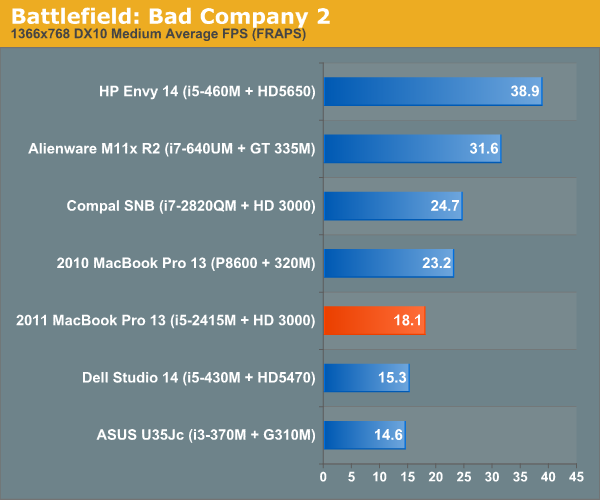
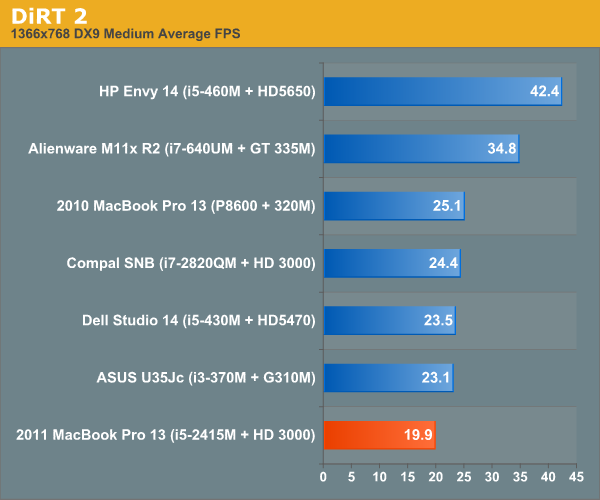
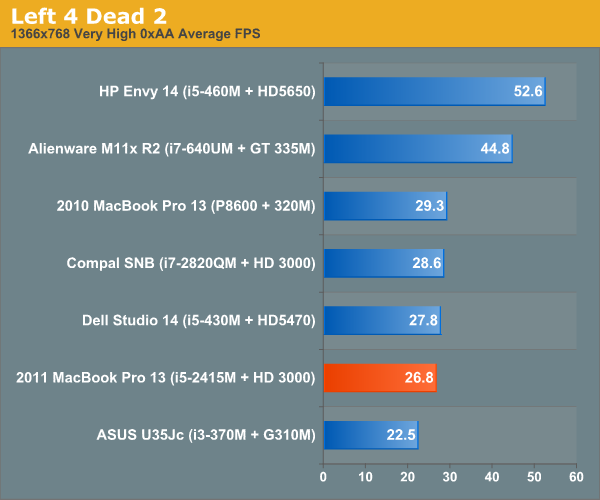
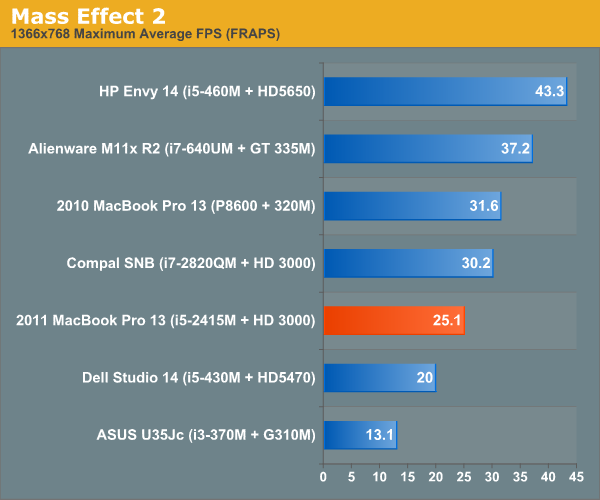
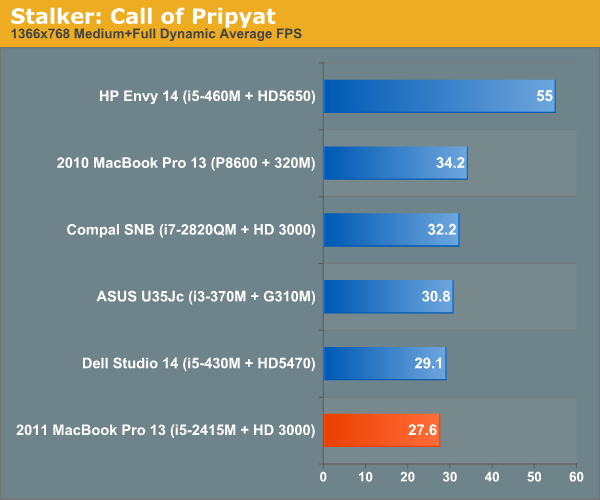
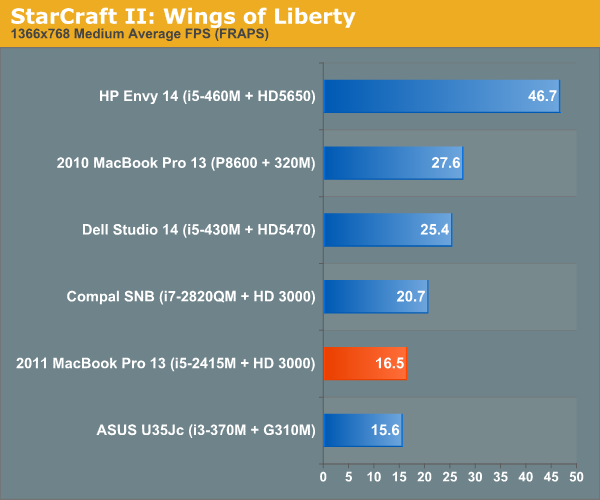
We see a similar result in the Cinebench 11.5 OpenGL test—a 24% decrease in performance relative to the old MBP.
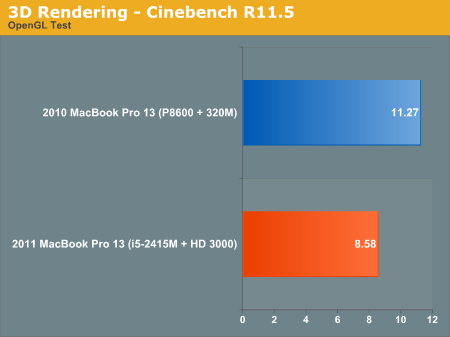
Given the huge leap in CPU performance, I'd have been okay if the graphics stayed on par with the previous MBP 13, but I was a little disappointed to see it that much slower. This is a weird one, since the same GPU gave us significantly better performance in the SNB test system. The only explanation we have has to do with turbo. The max turbo supported by the HD 3000 in the Core i5 2415M is 1.2GHz, down from 1.3GHz in the 2820QM. Now max clock speed isn't enough to explain this performance difference, but perhaps under Windows the 2415M's GPU doesn't turbo up quite as aggressively as the 2820QM's.
Anand consistently saw 10-15% faster results during the first run of a benchmark than the next four or five runs of the same test. This is probably due to thermal limitations—heat soak and overheating are pretty time-honored MBP traditions. However, my system shouldn't have been affected by thermal stress over time—I let it sit for some time between each benchmark run to let it cool, just to eliminate residual heat as a factor.
Based on CPU-Z, Apple isn't underclocking the GPU—it's running at the same 1.2GHz that's on the Intel spec sheets. The difference in performance is a little odd. The MacBook Pro, especially in 13-inch form, does have the potential to be thermally limited due to the size of the enclosure, but I'm not sure why a supposedly low-power graphics solution would be so thermally limited, even when testing to avoid the effects of heat build up as much as possible.










198 Comments
View All Comments
iwod - Friday, March 11, 2011 - link
iPad is only just starting to sell and iPhone still has lots of space to grow. The trend is Apple are making more units and more money from ARM specific products.Nvidia has just recently stated that Project Denver will be ARM 64 bit. And aiming at HPC and Desktop. Full Compatible with current ARM instruction set.
Currently Apple must have a ARM version of Lion testing, and few years down the road, they could switch their Mac over to ARM 64 bit. Using a single Instructions Set for their whole product line.
For some reason i have been thinking that Apple and Intel aren't doing too well together like anand has felt. I dont think Thunderbolt is any indication of their current relationship. it is merely they have been working on it for such a long time, no one wants to lose our at the end.
Of coz it could have been the other way round x86 moving into iPhone, although that depends how much intel is willing to bend towards apple.
jbh129 - Friday, March 11, 2011 - link
Anand,Can you guys run your high-end 15 through the Windoze tests that were used on the 13?
Thanks
tajmahal42 - Friday, March 11, 2011 - link
Hello guys!First, I have to say this review is really awesome, as usual! Just what I was hoping for. The thoroughness and practical sense of your reviews continues to amaze me every single time.
For the 13" MBP, you mention "bouts of instability". Can you elaborate on that? Stuttering? Crashes? In what way do you notice that instability? I'm a little concerned now.
tno - Friday, March 11, 2011 - link
+1alent1234 - Friday, March 11, 2011 - link
my wife has been bugging me about our wifi since we moved and get a poor signal in a lot of the new apartment. told her i can get a new router with 3 antennas but we will also need a new laptop as well with the antennas to take advantage of it.which brings me to my question. i know the 15" model has the 3 antennas. does the 13" do MIMO as well?
tipoo - Friday, March 11, 2011 - link
They all use the new card.By the way, have you tried switching wifi channels, or installing DD-WRT and boosting signal? Even so, you don't need a new laptop after getting a new router if signal strength was the only problem.
alent1234 - Friday, March 11, 2011 - link
i'll try that, thxa lot of wifi around me these days. we only have work laptops now so that would be our only personal computer if we bought one. i was looking for the cheap SB models when they come out
name99 - Friday, March 11, 2011 - link
"told her i can get a new router with 3 antennas but we will also need a new laptop as well with the antennas to take advantage of it."This is not completely true. A base station with multiple antennas CAN do the equivalent of phase-array beam steering to direct most of the output power towards the target laptop. The laptop will thus see a stronger signal, and one of the better modulation schemes (eg 64-QAM 5/6) can be used rather than one of the weaker schemes. Thus your laptop, even if it has only one (or two) antennas can still see better performance.
Note, this is a theoretical possibility. I do not know the current state of the art in how well base stations utilize the various forms of transmit diversity that are available. And no review ever seems to talk about this stuff, either by testing how well the kit works with a single antenna device, or by talking to the manufacturer about what's in their product.
Brian Klug - Friday, March 11, 2011 - link
The 13" does have 3x3 MIMO as well, the exact same broadcom solution as the 15" I tested extensively.-Brian
7Enigma - Friday, March 11, 2011 - link
Anand and crew,I am very disappointed with the battery life numbers in this review. This is the first review of a laptop where it appears you have used a 3rd party app (Cody Krieger's gfxCardStatus tool) to significantly inflate the numbers of the new 2011 systems. 35-60% by your own numbers back on the discrete GPU battery life page, which you then fail to report in the battery life tables later on!
When you are tasked to review a system (especially an Apple product I might add) it should be reviewed as is, with no tweaking or 3rd party add-ons to boost performance/benchmarks. When have you EVER installed an add-on for a Windows-based laptop to improve performance/life? I can't think of one.
At best this was a simple oversight where you have benchmark numbers WITHOUT the gfxcardstatus, at worst this was a cover-up job which I have always argued in the forums against and on your site's behalf.
Please update the tables to show what a stock newly-purchased laptop at the Mac Store would deliver.
I am very disappointed in this coverage.